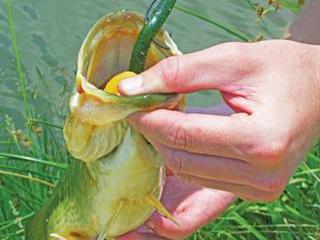
No matter what day of the week or what time of the day, passionate bass anglers concentrate intently on the spot to where they cast. Super accurate casting is vital for success in bass fishing, far more so than the tackle or lure/bait being used. The reason stems from the main characteristic of the largemouth black bass: its love of structure and cover.
It always lurks in the shallower margins close to the shore: an ambush predator, combining the stealth of a leopard with the short-track speed of a lion. It does not rush around trying to gulp anything and everything that comes its way, but lies in wait until the prey is within reach – be it a small fish, frog, lizard, insect or even a newly hatched duckling.
Anglers have exploited this characteristic for generations, placing their lures next to or in every object that can provide the bass with an ambush vantage point – an uneven lake or river bottom (called ‘drop-offs’), old river beds, surface and submerged aquatic vegetation, underwater boulders and man-made structures such as bridge pilings and jetties.
The art of luring
The bass’s menu has spawned an international multi-billion dollar artificial lure industry, with lures imitating small fish, frogs, insects, lizards, worms and even no living creature at all but merely creating noise and/or vibrations in the water. All are designed to attract the attention of a bass and trigger an attack, whether from hunger or just plain aggression.
The bass is not known for its docile nature: it is an aggressive eating machine, a characteristic that has pushed it to the top of millions of sport anglers’ target lists. For competitive bass angling, a dedicated bass boat is essential, but 95% of bass fishermen are bank anglers who ‘go bassing’ for pure enjoyment.
In the US, the ‘home’ of bass angling, there are about 45 million licensed bass anglers, and more than 600 000 paid-up members of the Bassmaster organisation. About 10 000 full-time professional bass anglers are the role models of the sport. In South Africa, a similar organisation exists, the SA Bass Angling Association, but the numbers are far lower – only about 1 100 affiliated competitive anglers and about 50 000 purely recreational anglers.
Not that the bass cares one hoot about who is an amateur or a professional: most of the lures cast at it throughout the year represent some type of food organism and are fair game. Nor does it care that bass fishing is served by a massive tackle and lure industry, or publicised by any number of television programmes, magazines, DVDs, radio programmes and newspapers. Certainly the five fish that made up the winning bag at this year’s Bassmaster Classic in Louisiana, US, do not know that their rash attack on the lures presented by the winner, Chris Lane, won him US$500 000 and much more in endorsements.
The approach
Meanwhile, the angler slowly creeps along the shoreline, keeping a low profile so as not to spook the fish. In bassing parlance, “if you can see the fish, it has already seen you”. About 20m to the right and about 5m offshore is a clump of pan grass pressed up against a boulder. With a six-foot, six-inch graphite pistol grip rod that can cost anything from R200 to R4 500.
On it is mounted what is called a low-profile baitcaster reel (entry level models cost less than R100 with top of the range ones at about R5 000). The reel is spooled with fluorocarbon line (about R4/m) and on it is tied an artificial minnow fish, a ‘crankbait’, so called because it is cast out and retrieved by cranking the reel handle. The myriad lures available can cost anything between R20 and R200.
On the nose of the bait is a plastic ‘beak’ that causes it to dive and wobble side to side as it is retrieved. Because this particular dam has many small bream, this lure has been chosen for its dark green back and a pale, almost cream-coloured belly. Eyes are painted on either side and the throat area is red. On the retrieve, it dives to two feet below the surface, just about in the sight range of a bass lurking just to one side of the boulder.
The side-to-side wobble sends out vibrations for the bass’s lateral line to pick up. With its senses highly aroused, the bass starts to position itself to strike, and as the angler retrieves the bait past the boulder and just to the side of the grass so as not to become entangled, the bass lunges forward, covering the one or so metre in a split second.
The bait is engulfed in its hard, bony, bucket-like mouth; its lips are lined with tiny, rasp-like teeth and once engulfed, no live organism can escape. The angler reacts to the strike as quickly as humanly possible, lifting the rod to the 12 o’ clock position. It bends alarmingly, but is designed to do so, cushioning the shock on the line and allowing the angler to guide the fish towards the shore.
But just as he reckons the fish is spent, it surges back to deep water, this time stripping line off the reel. The reel is equipped with a mechanism, called a ‘drag’ that releases line off the spool before its breaking strain is exceeded. With a properly set drag, an experienced angler can subdue just about any bass, no matter its size.
It takes the angler another few minutes – they can feel like hours – to pull the struggling fish near enough to grab its bottom lip between forefinger and thumb to subdue it. The action was short but highly intense, and the angler removes the lure and releases the fish. It is something of a contradiction that one of the world’s most delectable freshwater table fish is hardly ever harvested for food.
Outdoor sportsmen and women who take pride in calling themselves bass anglers are voluntarily bound by a policy of ‘catch and release’. But to satisfy the human ego to have a record of the catch to show peers, this has evolved to become ‘catch, weigh, photograph and release’. You will not see a dead bass at the scales during a bass angling competition, nor see a bass in a camp kitchen. Bass angling is indeed a passion that is all consuming!
Eugene Kruger is a freelance angling journalist and leisure fishing consultant. He is editor-in-chief of two angling magazines and SA representative of the International Game Fish Association.
Contact Abré J Steyn on 083 235 4822 or at [email protected].













